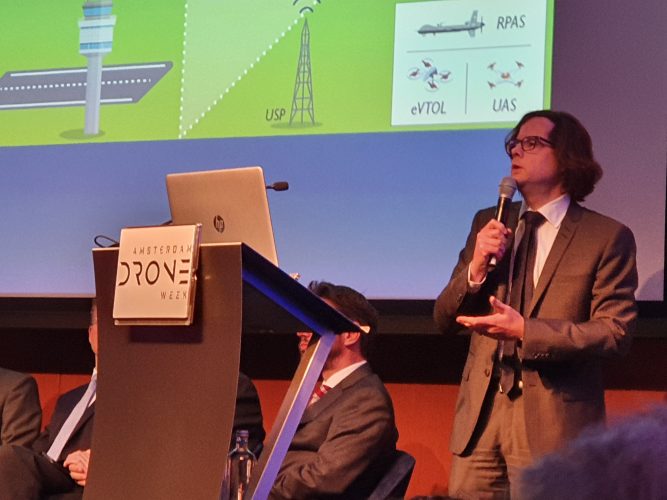There is a clear need for separation between UTM and ATM controlled airspace – air traffic controllers do not need to see every drone in the neighbouring airspace but the challenge will be for U-Space operators to manage the transition between the two regimes, according to Filip Cornelis, of the European Commission’s DG MOVE, speaking at the fourth meeting of U-Space network of demonstrators in Amsterdam.
But Antoine Martin of the DSNA argued that the challenge to integrate UTM and ATM was just too great and that it would take a decade to happen. The answer was to build an airspace management system in which all aircraft can be safely separated. “We already see manned and unmanned traffic integrated in controlled airspace, we just need to do it in a more efficient way.” There is no reason why we could not apply the same kind of collaborative decision making (CDM) procedures and technologies adopted by airports to link them into the European ATM network to the UTM and ATM scenarios, he said. “I have no problem if UTM service providers provide services in a built up area as long as I can do my job efficiently and this interface has been be agreed by both parties.”
According to Mark Watson of NATS in the UK there are over 300 drone infringements a year – so the answer is not segregation, because drones won’t keep to segregated airspace, but more efficient airspace management architectures overall.
Andreas Lamprech, CTO of AirMap, said U-Space is an essentially digital concept and we first have to define the areas where controllers will no longer be responsible for controlling.
Other participants spoke of the difficulties facing aircraft operators in negotiating different bands of airspace. “It is going to be difficult for the pilot to move from ATM to UTM and then through the different UTM levels, with having to change frequencies and so on,” according to Jörn Jaeger of Volocopter.
Another debate arose around the issue of standards. UTM standards from ASTM International for remote ID broadcast services for operators using electronic devices, along with the sharing of networked remote ID data, are due to be published in January 2019 and they could provide the bedrock for European U-Space systems, argued some delegates, even though European organisations had played only a minimal part in their development.
Other speakers said that any standards endorsed by the European Aviation Safety Agency (EASA) would have to be proven in the European operating environment. The European Commission had delegated the U-Space standards work to ASD Stan but using these standards under development for remote ID, for example, had not yet been tested in any of the U-Space demonstrator network programmes.
Other delegates reported that EUROCAE Minimum Operational Performance Specification (MOPS) for geo-fencing were nearly ready. Meanwhile the European Aviation Safety Agency (EASA) will now publish its U-Space draft regulations at the start of March 2019.
| The lessons learnt from Antwerp port and Enschede urban U-Space demonstration programmes
Antwerp port has hosted the SAFIR U-Space demonstrator programme which included two U-Space service providers – Amazon and Unifly – and many different types of drones performing several different tasks from monitoring emissions of berthing ships to pipeline surveillance and package deliveries. According to the port authority’s Erwin Verstrealen, the port has been involved with proof-of-value rather than proof-of-concepts and had demonstrated that U-Space works – but with some variations. “We need to define our future in the new regulation in an ecosystem of partners….but we would like to set the regulations at the local level… technology is moving towards autonomy.” The city of Enschede in the Netherlands has been pioneering a number of drone operations over the last few months but some of the most important results of the work has been achieved following the introduction of a drone surveillance system, provided by DJI, according to Wouter Asveld, of the city’s local authority. These include frequent violations of no-fly-zones and violation of maximum altitude rules on an almost daily basis. According to Henk Hesselinck of Dutch aerospace research agency NLR the VUTURA U-space demonstrator programme at Enschede one U-space service provider could detect drones flying with a 4G sim on board but the other could not. The demonstration focused on how flights in an urban environment should be prioritised. Three scenarios were trialled. In the first, a medical delivery drone flight was planned – where the transport of blood required a limited timeframe for delivery. Using the conventional U-Space system it took two minutes to alert all drone operators that a priority flight was being planned and would require a priority flight path. In the second scenario, an emergency defibrillator call-out was simulated – when the transport drone was equipped with an on board detect and avoid system the flight authorisation time fell to 15 seconds. The third scenario tested with an immediate drone launch by the fire service, which required all other drone traffic to immediately avoid the first responder drone flight. Lessons learnt included: flight approval may not be needed for each flight; a set of flight priorities may be needed; more automation is required and detect-and-avoid should be included in the U-Space system. Integration of airports and U-space is required along with improved guidance in completing the ICAO flight plan, especially when the number of people on board is zero – sometimes three flight plans were required when a drone flight was planned in airspace controlled by the nearby airport tower. |
(Image: Antoine Martin, DSNA)




